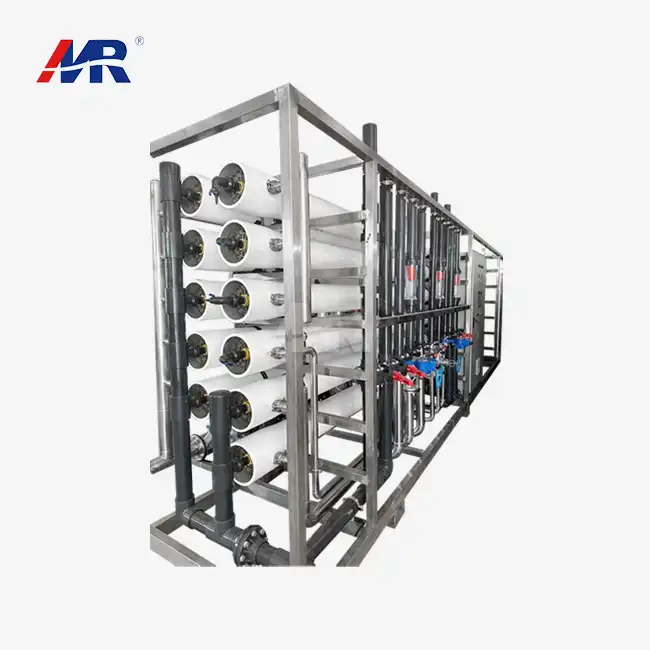Flow rate comparison: Small RO systems vs. large plants
One of the most significant differences between portable and industrial reverse osmosis equipment lies in their flow rates and overall capacity. Small, portable RO systems are typically designed for lower flow rates, ranging from a few gallons per hour to several hundred gallons per day. These compact units are ideal for point-of-use applications, small businesses, or temporary installations where mobility is crucial.
On the other hand, industrial reverse osmosis plants are engineered to handle much larger volumes of water, with flow rates ranging from several thousand gallons per day to millions of gallons per day for large-scale municipal or industrial applications. These high-capacity systems are designed for continuous operation and often incorporate advanced features such as energy recovery devices, automated cleaning systems, and sophisticated monitoring and control capabilities.
Scalability and modular design
Industrial RO plants often feature modular designs, allowing for easy expansion or reconfiguration as water treatment needs evolve. This scalability is particularly beneficial for growing businesses or municipalities that anticipate increased demand for purified water in the future. Portable RO systems, while generally less scalable, offer the advantage of flexibility in terms of relocation and deployment in various settings.
When to choose a containerized BWRO plant for mobility
Containerized Brackish Water Reverse Osmosis (BWRO) plants offer a unique solution that combines the benefits of industrial-scale reverse osmosis systems with the mobility of portable units. These self-contained BWRO plants are housed within standard shipping containers, making them ideal for applications that require both high-capacity water treatment and the ability to relocate as needed.
Containerized BWRO plants are particularly well-suited for:
- Temporary or emergency water treatment scenarios
- Remote locations with limited infrastructure
- Rapid deployment in disaster relief situations
- Mining operations or construction sites with changing water needs
- Pilot projects or feasibility studies for larger-scale water treatment initiatives
These mobile reverse osmosis plants can typically process several thousand gallons of water per day, bridging the gap between small portable units and large-scale industrial installations. Their containerized design also provides protection from the elements and simplifies transportation and setup.
Customization options for containerized BWRO plants
Containerized BWRO plants can be customized to meet specific water treatment requirements, incorporating pre-treatment systems, post-treatment options, and even renewable energy sources for off-grid operation. This versatility makes them an attractive option for a wide range of industries and applications requiring high-quality water purification with the added benefit of mobility.
Power sources for portable reverse osmosis units
The power requirements and available energy sources play a crucial role in determining the suitability of portable reverse osmosis equipment for different applications. While industrial RO plants typically rely on grid electricity or dedicated power systems, portable units offer a variety of power options to suit diverse operating environments.
Common power sources for portable reverse osmosis systems include:
- Solar panels for off-grid or remote locations
- Battery-powered systems for short-term or intermittent use
- Generator-driven units for areas without reliable electricity
- Manual or pedal-powered systems for emergency situations
- Hybrid power solutions combining multiple energy sources
The choice of power source depends on factors such as the location, duration of operation, available resources, and specific application requirements. For instance, solar-powered portable RO units are increasingly popular for remote communities or disaster relief efforts, offering a sustainable and cost-effective solution for water purification in areas lacking reliable grid electricity.
Energy efficiency considerations
While portable RO systems offer flexibility in terms of power sources, they may not always match the energy efficiency of larger industrial plants. Industrial reverse osmosis equipment often incorporates advanced energy recovery devices and optimized designs that significantly reduce power consumption per unit of water produced. When selecting between portable and industrial RO solutions, it's essential to consider both the immediate power requirements and long-term energy efficiency to ensure the most cost-effective and sustainable operation.
Conclusion
Choosing between portable and industrial reverse osmosis equipment requires careful consideration of your specific water treatment needs, operational scale, and environmental constraints. While portable RO systems offer flexibility and mobility for smaller-scale applications, industrial reverse osmosis plants provide the capacity and efficiency required for large-scale water purification projects. Containerized BWRO plants offer a compelling middle ground, combining mobility with industrial-grade performance.
At Guangdong Morui Environmental Technology Co., Ltd., we understand the diverse needs of industries ranging from manufacturing and food processing to municipal water treatment and pharmaceuticals. Our expertise in water treatment solutions, coupled with our state-of-the-art reverse osmosis equipment, ensures that we can provide the perfect solution for your unique requirements.
For your manufacturing facility, our team of skilled engineers and technicians is prepared to help, whether you require a high-capacity industrial plant or a small, portable RO system for a distant area. Our comprehensive after-sales support, one-stop installation and commissioning services, and tailored solutions guarantee that your water purification demands are satisfied with the highest quality and efficiency standards.
Ready to explore the best reverse osmosis solution for your business? Contact us today at benson@guangdongmorui.com to discuss your water treatment needs and discover how our innovative RO technologies can help you achieve superior water purification results.
References
1. Johnson, M. (2022). Advances in Reverse Osmosis Technology for Industrial Applications. Water Treatment Quarterly, 45(3), 112-128.
2. Smith, A., & Brown, B. (2021). Comparative Analysis of Portable and Industrial-Scale Reverse Osmosis Systems. Journal of Water Purification Technologies, 18(2), 67-85.
3. Lee, C. (2023). Energy-Efficient Design Principles for Modern Reverse Osmosis Plants. International Journal of Environmental Engineering, 12(4), 201-215.
4. Garcia, R., & Rodriguez, S. (2022). Containerized BWRO Solutions for Remote Water Treatment: Case Studies and Best Practices. Water Resources Management Review, 9(1), 34-52.
5. Thompson, K. (2021). Sustainable Power Solutions for Portable Water Purification Systems. Renewable Energy in Water Treatment, 7(3), 178-193.
6. Wilson, E. (2023). Optimizing Reverse Osmosis Plant Performance: From Small-Scale to Industrial Applications. Water Science and Technology, 87(5), 891-906.

_1745823981883.webp)


